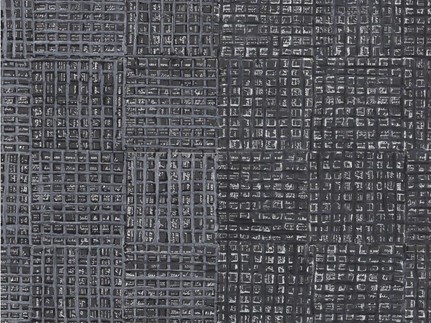Work is a foretaste - a preliminary
experience - of death.
Below: McArthur Binion, Route One: Box Two: IV, 2017
Above: Detail
Oil paint stick and paper on board
84 x 84 inches (213.4 x 213.4 cm)
Courtesy the artist and Lehmann Maupin, New York, Hong Kong, Seoul, and London.
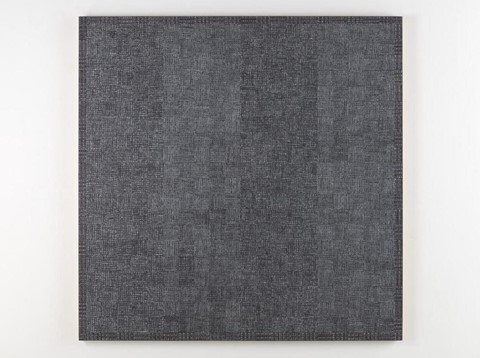
The Hand in the painting of McArthur Binion. First, the seductive surface. On approaching the painting of McArthur Binion – whether for the first or the umpteenth time – it is the surface that attracts, that seduces: the textures are soft and rich, delicate in the way that surfaces laid down by slowly made crayon or ink can be, the patient gridded lines clearly hand drawn, the face of the artist bent over closely to the plane, almost breathing on the soft crumbly surface of crayon and ink, the pressure of the hand, the fingers intent/tion – first intention, as it were – not only making but being captured simultaneously, not only depicting but being in the latency of the frame. There are moments, as in the DNA series exhibited in Chicago in 2014, when the surfaces of Binion paintings are like jewels of glistening light and as a viewer one simply wants to hold back a little and not hasten the reveal, not allow any perceptual moment to become too quickly resolved into an image – any image - but simply to allow the play of surface textures made by the varied force and lightness of this touch, this hand, of this artist. Rarely is it such a pleasure not to know, and simply to allow oneself, one’s looking, one’s seeing to be trained by the surface, led by the hand, through the touch of the work. At a certain distance, however, a sense of relief – physical relief – begins to allow itself to be glimpsed, and with it another kind of work, a kind of sculptural work of relief as forms – vaguely – allow hints of their underlying presence through the texture. At first, what seem to be other marks and markings, under-markings, are slowly revealed as letters, in rhythms of letterings, glimpses of words and wordings in groups revealing names / dates / locations sometimes in whole, often in parts. The medium reveals more than one support. Paper, maybe. Names. Numbers. Addresses. Yes. Dates. Or a map. Of Mississippi. Or photographs, fragments of photographs. Portraits / unknown? Anonymous? Self-portraits. Lynching. And all at once the perceptual plane dissolves, re-adjusts itself between the seductive and the repulsive, as if one part of the painting recoils from another in the same temporality as one part of the mind of the viewer also recoils in shock from its own recognition. At first, you, as viewer, think there is something buried – stories, histories – but the painting is a seduction in which the handling of memory is a masking of the blow without which masking there would be no distance to allow the viewer the time of recognition, of acknowledgment. The acknowledgment of work. The memories that are handled as phylogenetic memories, memories, that is, that an individual carries for a group, a species, a people: the child in a large family – in Mississippi – of cotton-pickers. The life of labor for an entire family and people. The geographic displacement of the family along with thousands, eventually millions of others from Mississippi and The South northward in search of work and a different state of mind – 12 Million Voices, says Richard Wright, seeking work and “to escape these marked-off areas of life.” Art is, though, a marked-off area of life for the young Binion, a zone of engagement that allows for needed autonomy from the family, as well as offering a means to reflect upon the labor of the family and the nature of labor to which the family – the species – is condemned, or, too, labor as means of escape, liberation. Suddenly the many beautiful, troubling textures of Binion’s oeuvre seem to assume a figuration – the hand – and a subject: what the hand, the instrument of instruments, as Aristotle put it, does, namely, work in the construction of a world. I think of the recent works – for example, the paintings in dialogue with Saarinen in the recent Binion / Saarinen: A McArthur Binion Project at the Cranbrook Art Museum – of which Route One: Box Two, 2017 [oil paint stick and paper on board] has become something of a talisman for me for the way in which the minimalist grey surface of grids yields to grids nested within smaller grids – from the frame to the clear sense of the division of the picture in two halves, then into larger boxes, each diminishing into a smaller scaled version of itself nested within to reveal the movement of language as a form of light within the smallest hand-drawn and so not quite rigid grid, almost as though the grids, that is, the unit of measurement, are made up of bodies (metonymically: the middle passage?) not abstract (modernist) forms, bodies delivered by hands… The Standard Certificate of Live Birth [in Mississippi] can be read in several of these works including Lehmann Maupin’s Route One: Box Two. The standard is the abstract norm, but the part refers to what has been delivered by hand, namely, the result of labor, the living body of the child. The hand, in Binion’s work, is a stand-in, a metonym, for labor, fragility, death.
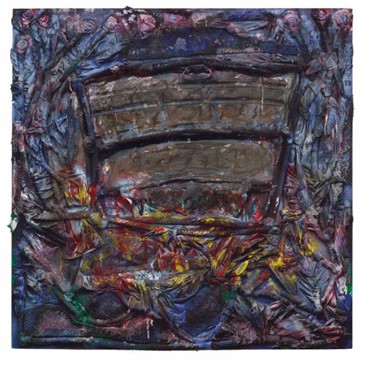

For Jane Schulak + Culture Lab Detroit
It is present with equal insistence and knowing literalism in Theaster Gates’ Tar Painting series, 2012, inspired, he says, by the labor of his father as a roofer; and think, too, of Gates’s 2012 White Cube exhibition My Labor is my Protest where, in conversation with Tim Marlowe,2See the website for My labor is my protest at White Cube, including the conversation between Theaster Gates and Tim Marlowe from which all my … Gates speaks of exploring through his practice “a conversation about labor [and] the role of performance and the possibility of beauty”; where, in the same interview, he also says that “my dad was a roofer for much of my life, and I think that I’ve come to my creative hands as a result of learning to build buildings and roof with him.”3On the cultural and class significance of the work of the hands, cf. Janet Zandy, Hands: Physical Labor, Class, and Cultural Work (New Jersey: … Finally, Gates explicitly situates his father’s labor as a form of sacrifice which frees him, Theaster Gates, from the need to be angry: “and part of the reason that I have the luxury of not being angry is because my dad labored so hard - so there is a consciousness of the history of struggle.” (Theaster Gates in conversation with Tim Marlowe, White Cube website, 2012). Most telling in the White Cube conversation, however, is Gates’ (acknowledgment of) mourning the death of his mother in 2010 of whom he says that she helped make his work possible even as she did not understand it but, even more pointedly, that he did not seek to bring her into his work, which is also to say, his world, and he did not wish to repeat this omission with his father. In another context I shall delve further into the language of mourning - the public act - shared by Gates in this conversation. Here, I simply wish to foreground the connection Gates establishes amongst labor (both his father as a roofer working with tar and his mother in some sense subsidizing the beginning of his art), mourning (his mother, but also proleptically his father of whom Gates says that he did not, after the death of his mother, want to repeat the same mistake with his father), and Art (here represented by “Jasper Johns,” in a tellingly odd passage the sense of which requires that it be treated as a parenthesis and the sentence incomplete). I quote in extenso as it is in many ways a remarkable passage:
My mom died in 2010, and I think that I really hated myself for not having her
understand better what I was up to on the day-to-day; and especially because she
financed so many of my crazy ideas … I just never gave her the nod, the respect,
to trust that she would understand this crazy world that we occupy, and I just didn’t
want that to happen with my dad. (In a way, we could say that the Tar works are a kind
of response to … um … Jasper Johns … that there’s a … that from reading about Johns,
there was a kind of insistence upon only considering the work at even, you know, as
people move on, they say, “No, Johns, that was about your dad, man! It’s about,
you gay, dude! You gotta deal with that! You gotta deal with that!” “I’m not gay! This is
not about my father!”) And, so, I think that in a way, my dad’s 78, my dad’s gonna pass
[...] my dad is aging, and it just seemed, it was only this moment that I realize that my
first Gift was roofing, and that my dad was actually the beginning of my artistic practice,
because I had to labor with him, and I had to help him take care of his buildings as a very
young person - and I never thought about that as fodder,4Difficult not to hear father, also content, the father as content. potential fodder, until I was in
the middle of my show here, and I realized that in these moments, when my dad is aging
and things are decaying - spring is turning into winter in his life5Listening to Theaster speak, the poetic register is not merely in the (surprising?) diction - “when my dad is aging and things are decaying - … - that I didn’t want to
miss the opportunities [...] from having direct engagement with the people I love … and I
felt that my dad had loaded content that was super good and he was a helluva of a
fabricator who could roll with me through a successful body of work!
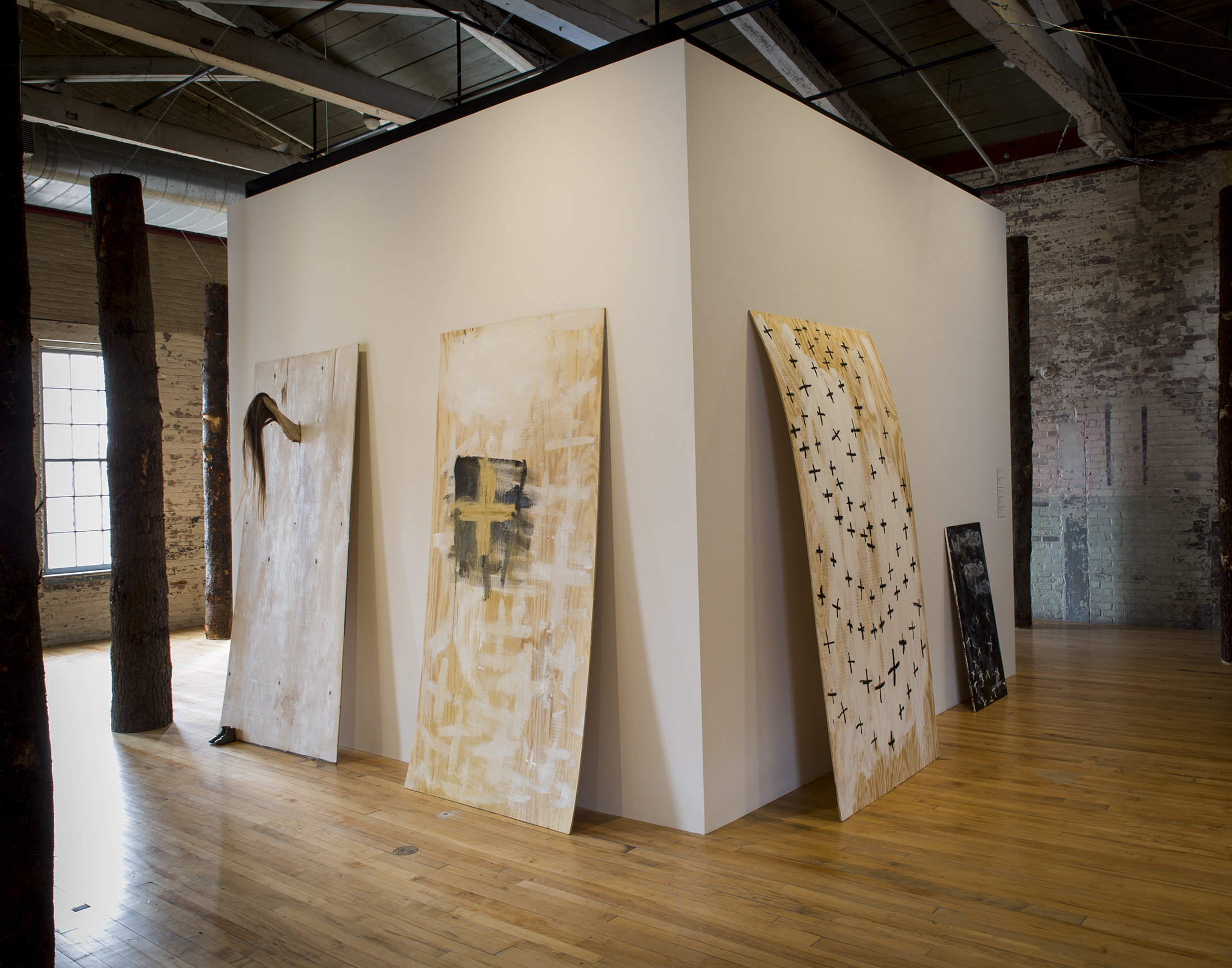
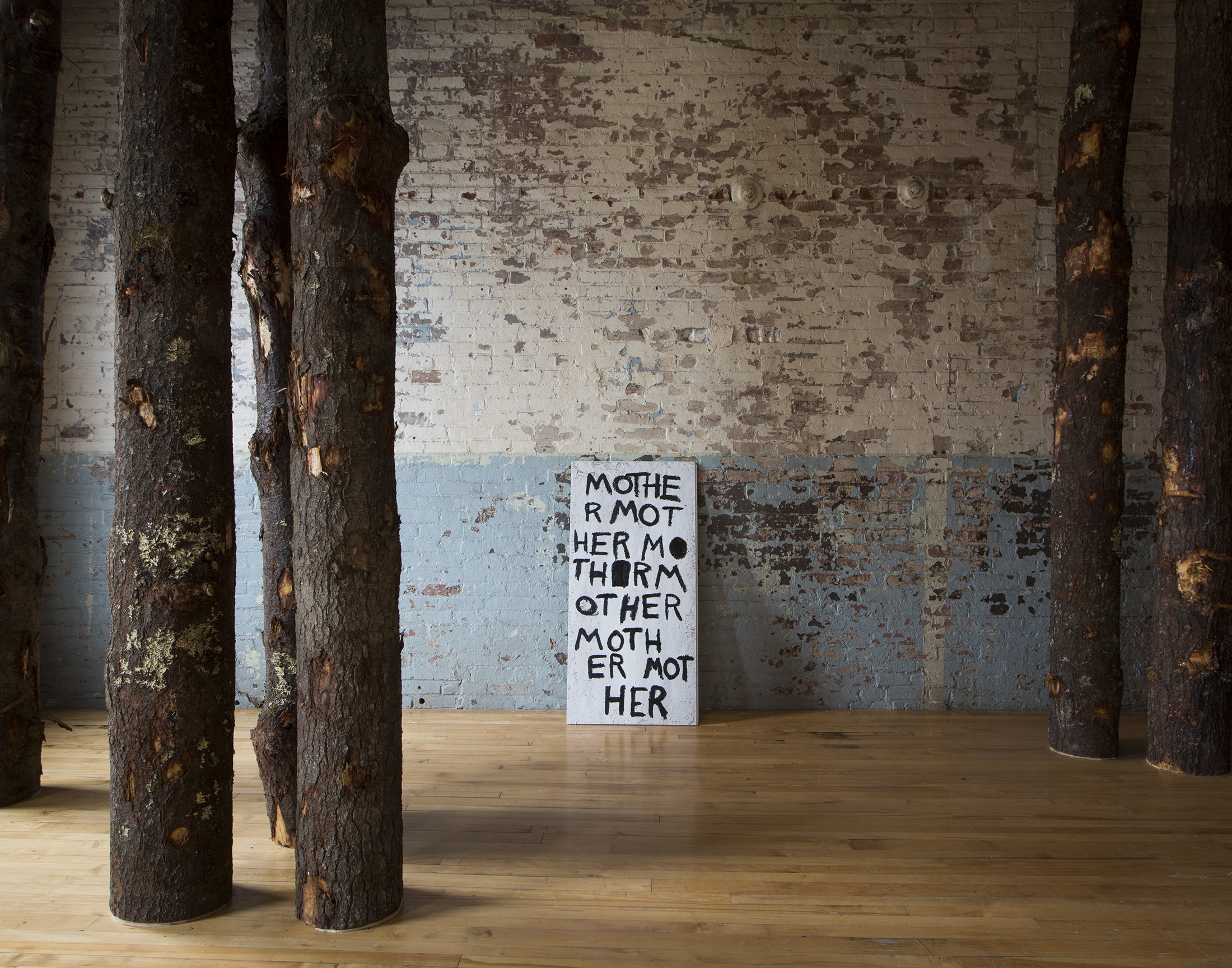
Alison Janae Hamilton, Pitch, detail, 2019 MASS MoCA
Quick - as there will be other occasions to unpack in detail this remarkable passage: In this passage Gates discusses the following implicit relations:
Consistently labor is the physicality of what is undertaken by the working-class father (tar, roofing), whilst Johns produces work, and Gates says that his father can roll with him, Gates, “through a successful body of work.” Again, moving quickly, Gates wants to say that Johns represents a conception of Art that insists on the work itself, by which one presumes he means a certain kind of autonomy of the work of art and the mental processes that it entails or entrains; Gates, on the other hand, at least in this moment of acknowledgment in “direct engagement with the people I love,” wants labor, contra Johns, to represent - or better, even, indicate, point to - a beyond of Art, an outside of Art, beyond the white cube (“there are things that are more important to me than White Cube gallery,” he will say): labor is one such, but so, too, is mourning. This outside of Art can lead to a revalorization of Blackness in Art as well as Blackness and Abstraction. The association of Blackness with labor marginalizes it in terms of modern art (and such is also the case for working class art per se in the economy of modern art6And this is so even in spite of the deeply felt valorization of folk art and song, of which the Negro Spirituals are very important examples along … ), but the implicit relation with mourning, Black mourning, might change the way of thinking about the materiality and language of abstraction - not Malevich, not Mondrian - to allow a conception of abstraction based upon neither a semiotic of disembodiment (say, primitively: Aurier; say, in its most powerful technology: Mallarmé, but in all cases post-symboliste) nor the historicity of art language (say, Binion and Whitten speaking always about not being of art history),7Jack Whitten: “LEARN TO HATE THE HISTORY OF ART AND ABOVE ALL DON’T TRUST IT.” Whitten, “Studio Log, 8 October ‘98,” Notes from the … but rather a conception of abstraction as veiling (of grief) or masking (of power) anchored in different material practices, whence labor.8I have outlined a conception of abstraction in terms of veiling and masking in Michael Stone-Richards, “Underneathness - Surface - Work in McArthur … The Tar paintings declare in all their surface viscosity the class-based labor of the father: there is nothing to see beyond it (there is no transcendence à la Mondrian, à la Malevich, or Kandinsky): this black substance is the substance of labor itself. It is pure function. It fits where it must. The Tar works also and simultaneously block vision - there is nothing to see into - and so they veil, protect the grief of loss (the personal), thereby making for (public) mourning.
More than ever I regret that I was not able to be present at this exhibition at the White Cube gallery in London! It is only after listening to this remarkable passage and requesting permission to reproduce an image of Gates producing Tar work with his father - an image which I first encountered online - and was politely informed that “This is not a work that we allow to be reproduced” that I began to think more clearly as to why it might be that the photography of Gates and his father with Tar work production as reproduced in the exhibition catalogue, My labor is my protest, are all reproduced in varying degrees of low-res quality.9See the low-res photographs of Tar works and the instruments of tar work (brush, truck, etc.) concluding with a portrait photograph of The Artist and … (A new kind of low-res, different to what appeared in the 1980s in mail art, is now current in advanced practice: in Paul Chan’s Waiting for Godot in New Orleans: A Field Guide (2007), in Arthur Jafa’s akingdoncomethas (2018), and in each case there is a distinct significance of mourning. - And may be this practice of the low-res as marker of mourning and limited un-masking might be seen, too, at work in Okwui Enwezor’s Catalogue for Documenta 11, Platform 5: Exhibition the first 30 (unpaginated) pages of which, compiled by Nadja Rottner, consist of montages of (relatively) low-res documentary photographs of various catastrophes of our modernity - AIDS, (civil) war, state terrorism, guerrilla terrorism, forced migration, genocide, scenes of sweat labor in the manufacture of consumer commodities - as if the lowered quality of resolution (but which of the available senses of resolution?) suggests a diminution, a lessening in some way (the mystery or the alchemy of the commodity?) the result of circulation within the neo-liberal economy of commodification.10See the Catalogue for Documenta 11_Platform 5: Exhibition (Kassel: Hatje Cantz, 2002). - The refusal of high definition (and the attendant refusal of circulation) might well be grasped as an attempt to guard, to secure, to retain something from dissipation and even prurience. It would be to keep from full view, and here in Gates, to convey the sense of the image as somehow incomplete and so not fully commodified.
I meet Larry Ossei-Mensah, then the new Susanne Feld Hilberry Senior Curator at Large for MOCAD. We share ideas about what we are working on. I speak of this set of reflections on the hand in Binion’s art, and the developing concern with Black labor in the Black avant-garde. Without missing a beat, he tells me of an exhibition called Pitch by the artist Alison Janae Hamilton that he co-curated with Susan Cross at MASS MoCA earlier in 2018. Alison Janae Hamilton is a photographer and installation artist born in Kentucky whose work is a reflection on the Southern condition – especially Black Labor. I can but quote from the accompanying text written by Cross and Ossei-Mensah on Pitch:
The title of both exhibition and a new installation, Pitch draws on a number of meanings
and associations. It suggests the inky black or rural nights and thick forest, as well as the
sounds and music that animate the landscape. It also refers to the resin of the conifers
tapped in the turpentine camps of northern Florida – an industry that bolstered the
southern economy from the Jim Crow era to the 1950s and relied on the grueling labor
of African-Americans. Evoking the towering pines characteristic of the area, the artist has
installed a grove of trees [Fig. 5 and Fig. 6] in the gallery. Ghostlike, they conjure the real
and metaphorical scars that the turpentine industry left on the environment.
(Susan Cross and Larry Ossei-Mensah, Pitch, MASS MoCA, 2018. Text available online at MASS MoCA website.)
There is of course more, much more, that can be said about this important work of an emerging artist, not least on the role of the “MOTHE/R […] HER” and related questions of natality... We could return to Gates’ Tar works and see in them, too, a deep concern with natality and the way in which natality foregrounds the need to change stories or narrative commencements. Suffice to say that a new visual language is being configured out of and around questions of world, world-making, subjection, and physical labor precisely when the digitization of representation (and lived experience?) has become irreversible - and maybe it is surprising just how varied is this visual language as it articulates a new subject in art.



And snow, scarce as any Northern cotton, or, David Hammons doesn’t work hard like James Brown
For Max Dax - Berlin / Detroit
W.E.B. Du Bois, “The Black Worker,” Black Reconstruction in America, 1860 - 1880
Finally, but by no means exclusively, this insistence on Black labor is present, too, in David Hammons’ Bliz-aard Ball Sale, 1983, Cooper Square, New York, near the Cooper Union Art School, where David Hammons laid out rows of snowballs for sale in New York City, for what is Bliz-aard Ball Sale if not the negative of Negro Work? Here is Hammons as recorded in an oral history: “I’m not working that hard. When you find a found object, the work is halfway complete.” (David Hammons quoted in Elena Filipovic, “The Color of Money,” David Hammons: Bliz-aard Ball Sale (London: Afterall Books, 2017), 79.) And: “I’m not going to put that much energy into an art object to prove to these folks that I’m legitimate. […] But now that I’m not going to spend like, uh, the rest of my life overworking, like James Brown, the hardest working man, he up sweatin’ and screamin’ and crawlin’ on the floor to prove to these folks that you’re a good singer. I’m not gonna do this shit.” (David Hammons, ibid, 79-80.) The art historian Elena Filipovic comments, “After all, what could be more simple and less work[-like] than making snowballs in winter?” (Elena Filipovic, ibid, 80.) This witty nonchalance is the reductio ad absurdum that makes the point of the labor of the black avant-garde, for as Hammons knowingly comments, “Ain’t no black person gonna pay you for a snowball. [laughs] That’s not gonna happen.” (Hammons, ibid, 89.) And Hammons has in mind not only “no black person gonna pay for a snowball,” he has in mind, or rather, the work brings into its orbit - its metonymic web - Black artists who are focused on the kind of work that would find - or is it, fit? - its market conditions, surrounded as Hammons was - especially in New York - by a commercial culture of painting where “Other Black artists [in New York] couldn’t understand why you would do it [produce something] if you couldn’t sell it.”11David Hammons, in Kelly Jones, “Interview with David Hammons,” EyeMinded: Living and Writing Contemporary Art (Durham: Duke University Press, … When Hammons, here in his interview with Kellie Jones, speaks of other Black artists, he has in mind other Black artists unlike Senga Nengudi who, in Los Angeles, was conceptual when he, Hammons, “was [still] working in frames,” but who, through sharing a studio with him, helped him become more conceptual just as she in response to his presence became more figurative, “That’s when she started doing the pantyhose [i.e., not your communal garden figuration, MSR]; those pieces were all anatomy,” and this following on from “when she used to put colored water in plastic bags and sit them on pedestals.” No one would speak to her and “She couldn’t relate.” Nengudi made the move to New York “and still no one would deal with her because she wasn’t doing ‘Black Art.’ She was living in Harlem. So she had to leave here and go back to L.A. and regroup.”12Hammons, “Interview,” 249-250. There is more than a little anger (mixed with astonishment? at the blindness? at the self-defeating lack of self-awareness?) in Hammons’ tone as, crucially, he points to a different economy: “Then I came in after her; I said: ‘I’ll try it, I’ll try it with my shit,”13Hammons, “Interview,” 249.
These things were brown paper bags with hair, barbeque bones, and grease
thrown on them. But nothing was for sale. [My emphasis] Other Black artists
here couldn’t understand why you would do it if you couldn’t sell it.
And:
I came here with my art in a tube. I had a whole exhibition in two tubes. I laid
that on the people here and they couldn’t handle it, nothing in it was for sale.15Hammons, “Interview,” 249.
Hammons speaks of the contact with Nengudi (“So by us sharing a studio”) as precipitating a new mode of practice which in being outside commodification resulted in forms or, better, following the late Pierre Fédida, informal substances from playing with bad areas, psychic bad areas and bad cultural areas: brown paper bags (bad enough) but with hair (Jews and Blacks have a thing or two about hair), and barbeque bones, and grease.16See Tom Finkelpearl’s conceptualization of this same material in terms of dirty materials, “On the Ideology of Dirt,” in David Hammons: Rousing … At their moment of origination these informal substances are outside the art frame and this feature or aspect alone allows one to grasp them as part of a collapse of the work (oeuvre) in a movement toward the event (evénément), and indeed, in both Nengudi and Hammons performance - with a pronounced cultural-therapeutic dimension which draws upon identifications in series and which also falls outside the art critical model of discrete form - will assume increasing importance. (Here, it becomes unavoidable, for me at any rate, not to see that Hammons’ description of Nengudi’s practice evokes the parallel practice of Lygia Clark and Clark’s movement from discrete abstract objects to performative object-situations with therapeutic goals.17On Lygia Clark, see Pierre Fédida, “Substance informe,” Par où commence le corps humaine: Retour sur la régression (Paris: PUF, 2000), … )

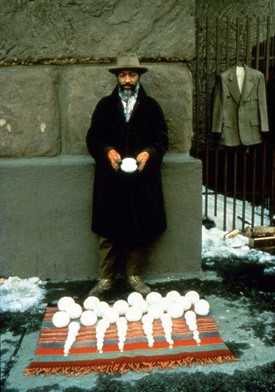
David Hammons, Bliz-aard Ball Sale, 1983,
Performance documentation.
Courtesy: Tilton Gallery, New York.
In light of the contact - and there can be no contact that does not leave a trace - and the encounter with Nengudi and the resultant playing with bad areas that makes available or possible the range of informal substances not for sale as outlined above, it remains that not only selves but objects, too, need testing, and the test (épreuve) here will be an object for sale that will survive the fact of exchange. Bliz-aard Ball Sale. A molded form prepared from (New York) snow, and so not an informal substance per se but one which nevertheless participates in the economy of anti-commodification essayed and prepared by the informal substances which emerged from play with bad areas.
Bliz-aard Ball Sale permits another angle on work / labor production and, through a series of metonymic associations, the cotton gin, for we need to be reminded that the cotton gin, as conceived for the Americas by Eli Whitney, was meant to lessen the burden of labor, but instead vastly increased and expanded the burden of labor on enslaved Americans and in such a way that it became efficient to employ - which is also to say, to enslave - vastly more Black Americans. The cotton gin had exactly the opposite effect from what its creator intended and thereby increased suffering in the world. Allow me to put this another way, Eli Whitney’s cotton gin is one of the most stunning illustrations avant la lettre of the Jevons Paradox, that paradox first formulated by the nineteenth-century British engineer and mathematician William Jevons that for any technology made more efficient the end result will be an increase in overall consumption of whatever material it is that one first sought to conserve. Increased efficiency necessarily leads to increased consumption. Hammons’ refusal of the idolatry of labor - of demonstrable and demonstrative expenditure of energy as figured through “James Brown” - might thus be construed as a refusal that recognizes that labor is the violent insertion of the subject into industrial time. (It is, after all, John Dewey, not Heidegger or Ernst Jünger, who speaks of that condition in which work becomes labor.) Bliz-aard Ball Sale, on this construal, is not, however, merely a token of non-work but rather a presentation through metonymy of an economy of work-anti-work-non-work in a landscape - of which the rug is a synecdoche18Robert Farris Thompson identifies the rug as a Moroccan rug and also observes, quite rightly, that the rug changed the situation. Cf. Robert Farris … - for the production or work-like construction of something like cotton - the metonym par excellence of violent labor which, pace Du Bois on “The Black Worker,” could build a new world - namely, snow balls. Here is Jean Toomer’s sonnet, “November Cotton Flower,” from Cane, with the onset of winter,
And cotton, scarce as any southern snow,
Was vanishing.
With the onset of winter, cotton vanishes from the South, and its attendant or associative violence hibernates, as it were. What if cotton - and its attendant violences - could reappear in the North as snow - a violent rainstorm (blizz, dialectal), or a violent blow (blizzard) - something in its way as equally light as (Northern) cotton? Here they are, lined up on a rug / landscape arranged like cotton balls rhyming with snowballs. A miracle? That such a transposition might occur? Or that anyone - but not a Black person - could pay for snowballs in winter in New York (or anywhere else for that matter where snow customarily falls)? Cotton does not grow in winter, and Toomer’s sonnet, “November Cotton Flower,” imagines the immaculate appearance of such a November Cotton Flower as correlative of a possible time in which something new comes into the world, something that not even Superstition had seen before:
Brown eyes that loved without a trace of fear,19My emphasis in order to mark what is immaculate in the sudden appearance of beauty.
Beauty so sudden for that time of year.
If cotton meant a new world, why might snow not also intimate (the equally spectral outlines of) a new world? A world not based upon labor, nor money and so where “all the realm shall be in common,”20King Henry VI, part 2, IV. ii. 65. a world, it might be said, where the common is based upon talking, the encounter through speech? Hammons:
When you have an object between you and them, people will talk to you. They’ll say,
‘What is that? Is it for sale?’ But if you’re just standing on a street corner, everyone’s
an enemy of each other. But one object… it becomes a conduit for conversation with
with someone you’ve never met before.21David Hammons, quoted in Filipovic, David Hammons: Bliz-aard Ball Sale, 73.
Du Bois on the coming of freedom to the enslaved at the end of the Civil War:
For the first time in their life, they could travel; they could see; they could change the
dead level of their labor; they could talk to friends and sit at sundown and in moonlight,
listening and imparting wonder-tales.22W.E.B Du Bois, “The Coming of the Lord,” Black Reconstruction in America, 1860-1880 (New York: The Free Press, 1992), 122.
“The first thing we do, let’s kill all the lawyers.” King Henry VI, part 2, IV. ii. 73. One day whilst listening to the radio I decided that I had heard this line followed by knowing giggles once too often and that it was time that I knew what it meant in Shakespeare. I pulled down my copy and started to read and was absolutely stunned to realize that the sentence is embedded in a workers’ discourse on justice, labor, and social rank, a not unimportant part of which was the desire on the part of those who labored to eliminate money - “there shall be no money,” and “All the realm shall be in common,” an expression of the realm being held in common would be conveyed through garment: “I will apparel them all in one livery,” as sumptuary laws would be abolished. To this end, “The first thing we do, let’s kill all the lawyers,” presumably as lawyers are part of the machinery of policing social order. The argument does not end here and there is more than a whiff of Pol Potism involved - Shakespeare will, after all, compose Coriolanus - but the issues bearing upon the relations between labor, rank, and justice are all present where “Virtue is not regarded in handicraftsmen,” even though “there’s no better sign of a brave mind than a hard hand.” Whence the injunction, “Labor in thy vocation.” (King Henry VI, Part 2, IV. ii. 15.)
Power and labor. Long before Marx, or Capitalists, for that matter, one of our oldest creation narratives, the Enuma Elish, and related Mesopotamian stories, made clear the cosmological significance of labor in the organization of societies. From tablet 1 of the Story of the Flood the problem is posed as follows:
When gods were man,
They did forced labor, they bore drudgery.
Great indeed was the drudgery of the gods,
The forced labor was heavy, the misery too much,23Story of the Flood, 1700 B.C.E., trans. Benjamin R. Foster, in From Distant Days: Myths, Tales, and Poetry of Ancient Mesopotamia (Bethesda, …
and don’t you know, the gods complained. Throughout these narratives there are variations on a theme for how the (lesser) gods escaped the drudgery of labor, but perhaps the most powerful version is to be found in tablet 6 of the Enuma Elish where, after an intergenerational battle between the first and younger gods, Marduk, leader of the victorious younger gods, takes a defeated god, Quingu, on whom symbolic punishment will be inflicted:
They bound and held him before Ea,
They imposed the punishment on him and shed his blood.
From his blood he made mankind,
He imposed the burden of the gods and exempted the gods.
After Ea the wise had made mankind,
They imposed the burden of the gods on them!
That deed is beyond comprehension,
By the artifices of Marduk did Nudimmud create!24Enuma Elish, 1900 - 1600 B.C.E., trans. Benjamin R. Foster, in From Distant Days: Myths, Tales, and Poetry of Ancient Mesopotamia (Bethesda, …
That deed is beyond comprehension - no matter the translation, the effort is to convey what a miraculous thing it is to be able to create a being, a creation requiring powers great and exemplary even for a god, a being to bear drudgery and labor and, miracle of miracles, for that being, created by a god, to accept its condition. Here is Marduk’s speech, Marduk’s promise to his fellow gods - the 1% of their day -
“I shall create humankind,
They shall bear the gods’ burden that those may rest.”25Enuma Elish, 38.
In other translations it is made clearer: So that the gods may be at leisure. The politics of labor is here the foundation of the politics of jouissance after which the architecture of society and sociality is wholly organized.
To the extent that Black art in the Western diaspora was anchored in, or sought, even at certain key moments, to valorize labor (let’s call this the Booker T. Washington world-view, which would become the Black capitalist / Nationalist world-view), then the very mode of representation expressive of such sociality and labor will indicate such effort as marginal to what was in the process of becoming the dominant ethico-aesthetic thinking of modernism - see Breton in Nadja as he walks against the (depressing) crowd headed home at rush-hour and thinks: Allons, ce n'étaient pas encore ceux-là qu’on trouverait prêts à faire la Révolution (Let’s keep going, it was not yet these people whom one would find ready to make the Revolution), which is not so far from General Baker of the League of Revolutionary Black Workers saying to Jerry Herron that “it takes quite a lot to get working men to riot. It ain’t easy!” A similar sentiment is also to be found in Eliot, Valéry, and Debord. This modernist refusal and rejection of labor - that, in any case, has long had a fully articulated social and political philosophy - is not because the conception of modernism at work here is concerned with aesthetic purity so-called, but rather, such labor and its attendant values is precisely what is to be overcome, is precisely what endangers the future models of sociality nascent in modernism the most compelling of which models bear on the refusal of money and commodification.29In another context, I shall touch on the life and work of Tillie Olsen as a way of exploring the way in which even, or may be especially, writers …
(An Ezra Pound refuses money, whilst a Georg Lukacs refuses commodification, and both Eliot and Breton seek new conceptions of order, the one religious - Anglo-Catholic social teaching - the other mythic - drawing upon Anarchist social thought. Peter Viereck always insisted that Anarchism was the only logical alternative to Conservatism!) We see this in Marx on time; Dewey on when work becomes labor; Debord on the ethics of time, and most recently in the powerful articulation of the conception of value in Marx’s critical theory by Moishe Postone:
We have seen, says Postone, that Marx’s presentation indicates that general historical
emancipation is grounded not in the possible full realization of the already extant form
of production but, rather, in the possibility of its overcoming. This critique is rooted not
in what is but in what has become possible - but cannot become realized within the
existing structure of social life.30Moishe Postone, Time, Labor, and Social Domination: A Reinterpretation of Marx’s Critical Theory (Cambridge: C.U.P., 2003), 360-361.
The standpoint of a historically informed critique, argues Postone, would be temporal rather than spatial and would involve not the “open realization of labor’s centrality to social life,” but recognizing instead that “labor’s constitutive centrality to social life characterizes capitalism and forms the ultimate ground of its abstract mode of domination. This approach interprets Marx’s notion of capitalism’s basic contradiction in terms of a growing tension between a form of social life mediated essentially by labor and the historically emergent possibility of a form of life in which labor does not play a socially mediating role.”31Postone, Time, Labor, and Social Domination, 361. (Let me add, here, that the spatial turn in critical theory of art practice, in what it presented as a rejection of the Romantic fetishisation of time, could never account for the way in which, through the commodity-form, time became medium and form of social domination under capital.)
People of African descent are often spoken of as a people of the Middle Passage, which means, minimally, people, creatures of labor. (Of course, “we” are all, in the modern world, people of the Middle Passage.) In the Cahier d’un retour au pay natal (Notebook of a Return to the Natal Land), a key moment in the articulation of Black avant-garde sensibility and poetics, Aimé Césaire expressed this idea of a people of the Middle Passage, and its related conception, that modernity is built on Black labor, as follows (and I quote in the translation of the late John Berger and Anna Bostock, the same translation used by a young John Akomfrah who would also in film meditate on the intersection of Black labor and modernity):
My name is Bordeaux and Nantes and Liverpool and New York and San Francisco
not a corner of this world but carries my thumb-print
and my heel-mark on the backs of skyscrapers and my dirt
in the glitter of jewels!
Who can boast of more than I?
Virginia. Tennessee. Georgia. Alabama.
Aimé Césaire, Return to My Native Land, 1939 / 1956, translation 1968.
Black labor is the name of the port cities of France, England, and the United States of America. An important aspect of the contemporary Black avant-garde has found here a new and surprising subject of art.
The movement between Hammons - anti-work, non-work - and Gates’ Tar paintings in My labor is my protest, permits a new practice of seeing and acknowledgment, a lifting of the disavowal inherent to aspect-blindness, as labor is thought in relation to refusal (anti-work and non-work) and mourning (the veiled grief of the Tar paintings) in the realm of symbolisation where alone the conditions of possibility of representation can be grasped, made figurable. The non-seeing made visible in the Tar works, the labor of sorrow - the overcoming of aspect-blindness on the part of the viewer, of which the maker is the but the first instance - becomes a figure of the kind of determinate negation required to make movement into the future a historical possibility. Here is the foundation of a new accounting of abstraction as the mourning - and the logic of separation - which makes possible abstraction (in painting, but also in representation per se) becomes linked to labor in the process of being superseded. Now, pace Alison Janae Hamilton and Theaster Gates, we can begin - but only begin? - to re-pose the question, What’s the matter, mother?
April 2022
References
